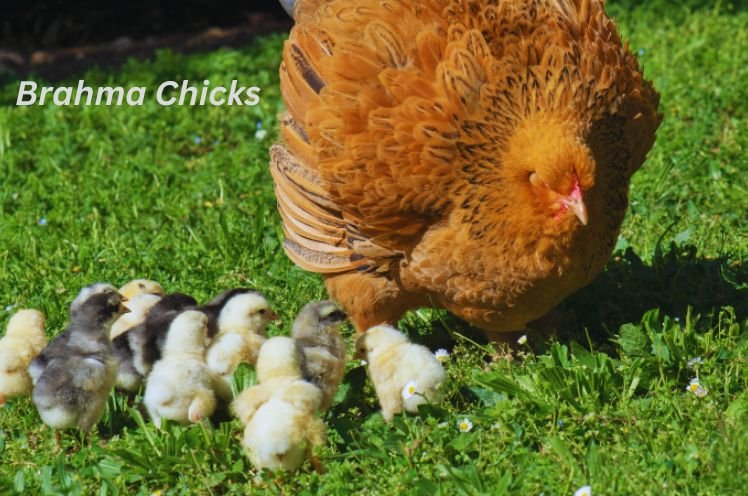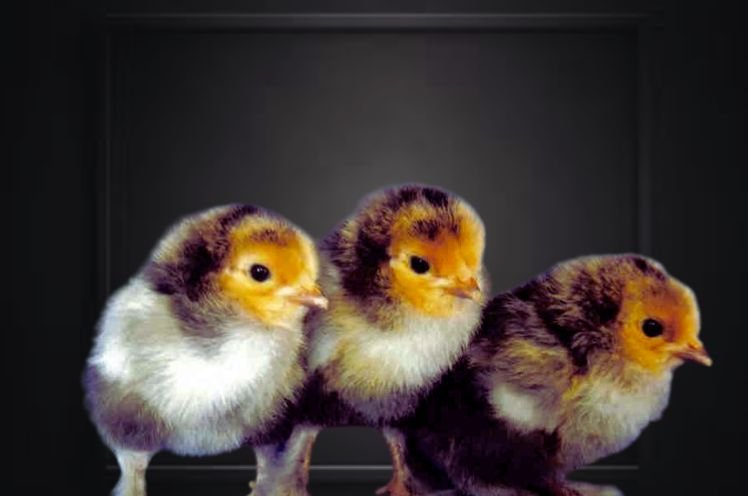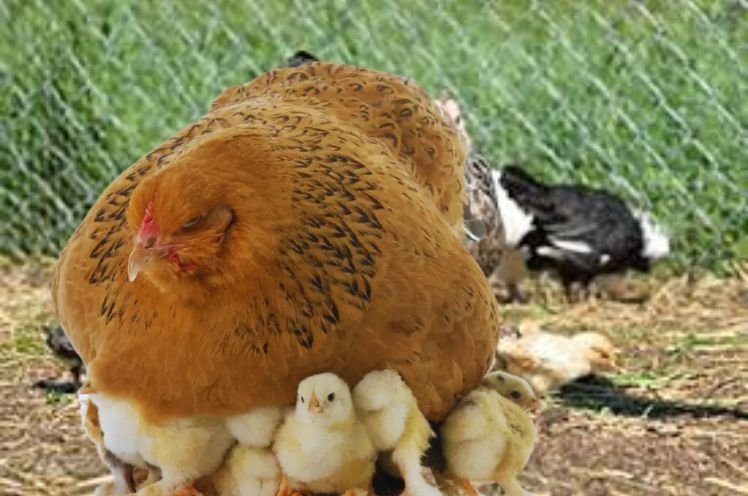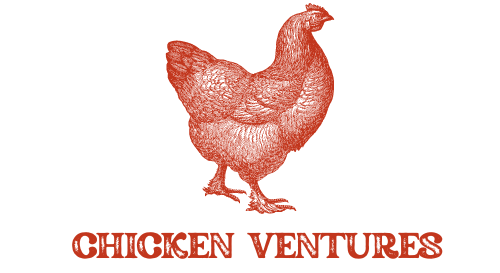Brahma baby chicks, as the name suggests, are very large, gentle, and calm, which makes them a farmer’s favorite. The chicks mature into beautiful and elegant chickens with relatively simple care requirements. In case you want to rear Brahma baby chicks, this article contains all the information that will guide you.
What are Brahma Baby Chicks?
Brahma chickens are large, dual-function poultry species that are primarily reared for meat and egg production. It mainly includes breeds that evolved from birds imported into the United States in the mid-19th century. Brahma breeders endow their babies with the same special features that people love about adult Brahmas.

Key Characteristics of Brahma Baby Chicks
- Size: From the time they hatch, Brahma baby chickens are larger than many other breeds of chickens.
- Appearance: Their appearance is characterized by a soft downing, primarily yellow, white, or grey. As they grow, we observe some developments; the feathers become slightly more structured, and the feathered legs and feet are visible from an early age.
- Temperament: The brahma chicks are tame and friendly, making them ideal for families with children to rear as poultry birds.
Types of Brahma Chickens
As mentioned, Brahma baby chicks are also available in many colors, making each type attractive in its own right. The most common types are: The most common types are:
Light Brahma Chicks
Light Brahma chicks are distinguished by their typically soft yellow down. When they grow up, they develop white plumage with black markings behind the neck, on the tail, and on the wings.

Dark Brahma Chicks
Dark Brahma chicks are often dark grey or black in color when they hatch. Chicks and young adults form their feathers in intricate patterns, characterized by a dark grey hue, a black line running through their body and wings, and a hint of silver or white.

Buff Brahma Chicks
Buff Brahma chicks have a cozy, warm, golden tinge about them. As adults, Acorn Woodpeckers have a very striking appearance, with a dark brownish black head, tail, wings, and back with a bright buff-cultured belly.

Raising Brahma Baby Chicks
Raising Brahma baby chicks requires special care, especially in the initial weeks. Here is a comprehensive guide that will assist you in raising joyful and healthy Brahma chicks.
Setting Up the Brooder
A brooder is essential for your Brahma baby chicks, especially during the first few weeks of their little lives.
- Temperature: Keep the brooder at 95 degrees Fahrenheit for the first week. As the chicks grow and develop new feathers, reduce the temperature by 5 degrees each week.
- Bedding: Use soft, absorbent bedding materials such as pine shavings. Do not use newspapers or other smooth materials that cause leg problems.
- Space: Invest at least 0. Each chick starts with five square feet of space, but as they grow, they get more.
Feeding Brahma Baby Chicks
Adequate attention to feeding and nutrition is necessary to support the normal growth and development of Brahma baby chicks.
- Starter Feed: Feed your chicks with a chic-starter of good quality with a protein content of between 18 and 20%. This will ensure their growth rate within the first 6–8 weeks of development.
- Fresh Water: Always make sure that the chick has plenty of water to drink; it should always be clean, free from any bad smells. Use shallow waterers for deep waterers to avoid drowning.
- Supplements: Adding vitamins and also probiotics to their drinking water will improve their immunity and gut health.

Growth and development
Because of their large size, Brahma baby chicks have a rather steady growth rate, but not as rapid as dwarf chickens.
- Feathering: Expect the chicks of ‘Brahma’ to be slower in their feathering process. They may appear untidy during this phase, but that is quite alright.
- Weight Gain: Make sure that the children regularly measure their weight to ensure proper placement on the growth chart. Brahma chicks should gradually gain weight each week.

Caring for Brahma Baby Chicks
Raising Brahma baby chickens is more than just feeding and sheltering the newborns. Here are some additional recommendations to help them thrive:
Socialization and interaction
Friendly and social, Brahma chicks like to be around humans.
Handling: For the chicks that you want to familiarize with your touch, you should handle them from a young age. To make them more manageable as adults, encourage school-aged children to finish.
Companionship: They are social birds and happy with their own kind, like other chickens. Perhaps one should raise them in groups to reduce the chance of the bird being lonely and also allow it to be as naturally animated as possible.
Health Monitoring
Despite being relatively healthy, Brahma chicks, like all poultry breeds, are susceptible to health problems. If we conduct high-frequency checks, we can detect the issues promptly.
- Respiratory Health: Check on broader ventilation; this is a common area to find respiratory-related issues due to dust or poor ventilation.
- Leg Health: It is often thought that Brahma chickens can easily develop leg problems due to their rapid growth rate. Make sure the brooder has a non-slip surface, and feed them balanced diets so that they have strong bones.
- Parasite Prevention: For the first few weeks of the chicks’ lives, you should inspect them daily for signs of parasites such as mites or lice. Regularly clean and check their surroundings to avoid the likelihood of the parasites infesting them.
Brahma Baby Chick Growth and Care Schedule
| Age (Weeks) | Feed Type | Temperature (°F) | Key Milestones | Space Required (Sq Ft/Chick) |
| 1 | Starter Feed (20% Protein) | 95°F | Downy feathers, first wing feathers | 0.5 |
| 2 | Starter Feed | 90°F | Wing feathers developing | 0.75 |
| 3 | Starter Feed | 85°F | Tail feathers appearing | 1 |
| 4 | Starter Feed | 80°F | Back feathers filling in | 1.25 |
| 5 | Starter Feed | 75°F | Fully feathered, can begin transitioning to grower feed | 1.5 |
| 6 | Grower Feed (16-18% Protein) | 70°F | Ready to move to outdoor coop | 2 |

Transitioning to the outdoors
Normally, you can move your Brahma baby chicks to the outside coop once they have fully feathered and summer has begun.
Preparing the Coop
- Perches: Since Brahmas are larger than other birds, they need lower perches. Place the perches 18 inches off the ground.
- Nest Boxes: Since Brahma hens are relatively larger in size and require a decent space to lay their eggs in, install big nest boxes. This book aims to assist men in connecting the women they are dating with their families, particularly their sisters and female friends.
Introducing Chicks to the Flock
One should never assume that the newly bought Brahma baby chickens are strong enough to fend for themselves whenever they are introduced to another established flock; to avoid cases of bullying and stressed-up birds, the integration process must be done gradually.
- See but Don’t Touch: Initially, separate the chicks from the older birds by physically isolating them, ensuring the area remains visible to them. This makes them familiar with each other without physical touch; this could be between opposite sexes, children, or animals.
- Supervised Meetings: Gradually, in about a week’s time, you should introduce the chicks to the rest of the flock, but make sure that they are first under supervision. Observe carefully to see if there are any signs of aggression, and if possible, remove one and take him or her to another location.
Raising Brahma Baby Chicks: Common Challenges
Raising Brahma baby chicks is usually easy, but there are some things to know.
1. Slower Feathering
Brahma chicks also feather out slower than most other breeds, which means that they may take longer to outgrow the brooder. However, ensure they don’t succumb to cold before they complete their feathering.
2. Leg Weakness
However, there are general health problems that are common in such small birds, and they include leg weakness or deformities in the legs of their chicks. It is important to feed the child good and high-energy foods that will help his growth and development by ensuring that he takes a balanced diet that contains vitamins and minerals.
3. Cold sensitivity
Changes in weather can easily affect the chicks, even though adult Brahmas are highly resistant to cold. In order to avoid stress and sickness, you should maintain their body temperature, and most importantly, keep the kids dry.

Conclusion
Hatching and rearing Brahma baby chickens is a hustle and a worthwhile project, no matter how experienced you are in poultry farming. You can use these docile, beautiful-looking birds for both egg farming and consumption. Proper feeding, management, and care can help your Brahma chicks grow into healthy and productive adults.
You are fully prepared to raise Brahma baby chicks, as this guide has enlightened you about the process. So, have fun, and in the shortest time possible, you will have a group of well-bred Brahma chickens in your backyard.
